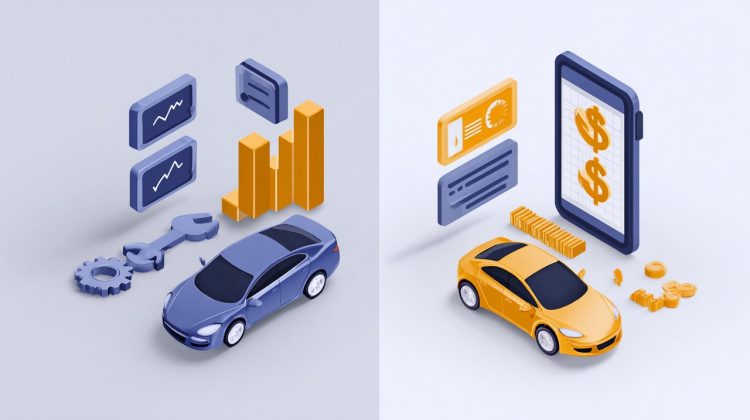The landscape of personal transportation is undergoing a profound re-evaluation. Consider a stark reality: in 2023, the average new car payment in the U.S. soared to an unprecedented $726 per month. This figure, critically, excludes the persistent costs of insurance, fuel, maintenance, and the silent drain of depreciation. Such an exorbitant financial commitment compels us to confront a fundamental query: Does car ownership truly retain its value when weighed against the burgeoning convenience of ride-hailing services? This is no longer a mere lifestyle preference; it is a complex intersection of personal finance, evolving urban dynamics, and individual priorities.

Navigating the Modern Mobility Landscape: Core Considerations
Modern urban environments now offer a vibrant spectrum of transportation choices. Historically, car ownership has been deeply intertwined with concepts of personal freedom and unbridled convenience. Yet, the emergence of ride-hailing platforms like Uber and Lyft has undeniably presented a potent alternative, fundamentally reshaping our understanding of personal mobility. This pivotal decision transcends simple transactional costs; it encapsulates considerations of overall value, practical convenience, and profound long-term financial ramifications. A nuanced grasp of these inherent trade-offs is indispensable for making truly informed choices. The ultimate “worth” of a car versus ride-hailing is, crucially, a highly individualized calculation. Factors spanning daily commute patterns, family dynamics, the availability of public transit, and one’s personal financial health each exert substantial influence. It demands a holistic assessment, far beyond a rudimentary tally of monthly expenditures.
A Deeper Dive into the Economics: Car Ownership Versus Ride-Hailing
To achieve genuine clarity, a rigorous financial comparison between car ownership and ride-hailing becomes indispensable. It is a common oversight to underestimate the comprehensive financial burden that car ownership entails.
The Multifaceted Ledger of Car Ownership: Explicit and Implicit Expenditures
The financial obligations tied to owning a vehicle extend considerably beyond its initial sticker price. These comprise a blend of both transparent explicit costs and more insidious, frequently underestimated implicit expenses. A comprehensive understanding reveals the following key categories of expenditure:
- Purchase Price: This represents either the immediate upfront capital outlay or the sustained burden of monthly loan installments.
- Insurance: A mandatory and often substantial expense, its variability is dictated by the driver’s profile, vehicle type, and geographical location.
- Taxes and Fees: These encompass a range of administrative charges, including registration fees, sales tax, and recurring annual licensing costs.
- Fuel/Electric Charging: A direct, recurring expense, intrinsically linked to vehicle usage and the fluctuating dynamics of energy markets.
- Maintenance and Repairs: This category covers everything from routine servicing and preventative measures to unforeseen mechanical failures and the inevitable replacement of components like tires.
- Parking Fees: A prevalent cost, especially within metropolitan areas, ranging from daily charges to monthly subscriptions or intermittent expenses.
- Depreciation: Arguably the most significant yet frequently overlooked hidden cost. A new vehicle rapidly sheds a considerable portion of its value within its first few years. To illustrate, a $30,000 car could easily depreciate by 20% in its inaugural year, equating to a $6,000 loss that never appears on a conventional monthly bill. This silent erosion of capital is a critical factor often missed in superficial cost analyses.
The Leaner Model: Deconstructing Ride-Hailing Expenditure
In stark contrast, ride-hailing services operate on a distinctly different financial paradigm: a pay-per-use model. This structure, while offering flexibility, comprises several key components:
- Per-Ride Fees: These charges are dynamically calculated, factoring in the distance traveled, the duration of the journey, and prevailing demand.
- Surge Pricing: A well-known variable, surge pricing introduces unpredictability by increasing fares during periods of peak demand or high traffic. This mechanism, while optimizing driver availability, necessitates strategic planning for cost-conscious users.
- Subscription Services: To mitigate some of the variability, certain platforms provide monthly passes or membership tiers, offering discounted rides or preferential access.
- Long-Distance Charges: Extended trips typically incur higher rates, potentially diminishing the economic advantage of ride-hailing when compared to a personal vehicle for very lengthy journeys.
A compelling advantage of this model lies in the complete absence of upfront capital investment and the perennial burden of ongoing maintenance costs—a significant draw for many urban dwellers.
Scenario Analysis: Unpacking Cost-Effectiveness Through Practical Examples
To effectively address the question of whether car ownership or ride-hailing proves more economical, let us examine two illustrative, common scenarios.

The Daily Commute: A Head-to-Head Comparison
- Scenario A: The Car Owner: Envision a daily 20-mile round trip commute. Factoring in a $500 monthly car payment, $150 for insurance, $100 for fuel, $50 for parking, and an estimated $50 for maintenance and depreciation, the total monthly outlay reaches $850. This calculation, while substantial, underscores the potential for financial leverage in car ownership for daily commuting when fixed costs are amortized over high usage.
- Scenario B: The Ride-Hailing User: For the identical 20-mile round trip, assuming an off-peak average of $15 per trip, this translates to $30 daily, or approximately $660 per month for 22 working days. This estimate, however, deliberately omits the unpredictable variables of surge pricing or occasional weekend travel. In this specific commuting paradigm, ride-hailing might initially appear more cost-effective on a per-month basis, yet the car owner simultaneously accrues other forms of utility and flexibility.
Weekend Family Excursions: A Different Scale
- Scenario A: The Car Owner: A family journey to a park 30 miles distant incurs minimal direct fuel costs, perhaps $5, with parking adding another $10. The total direct expense is a modest $15, with the vehicle immediately available.
- Scenario B: The Ride-Hailing User: The same 30-mile excursion could readily cost between $40-$60 for each leg of the journey, culminating in an $80-$120 round trip. This also introduces considerations of potential wait times and the logistical challenge of car seats.
These simulations compellingly demonstrate that specific usage patterns are the primary determinants of true cost-effectiveness of each option. High-frequency, daily utilization often skews the advantage towards ownership from a per-use cost standpoint, whereas infrequent and situational needs overwhelmingly favor the economic model of ride-hailing.
Beyond the Balance Sheet: Lifestyle and Convenience Trade-offs
The decision between car ownership and ride-hailing extends well beyond purely financial metrics, deeply impacting daily life and personal preferences. Here, we examine the qualitative distinctions:
- Unfettered Freedom and Adaptive Flexibility: A privately owned vehicle provides an unmatched degree of spontaneity and immediate access. The absence of waiting times for a driver or concerns about surge pricing for urgent journeys is invaluable. This autonomy is particularly pronounced for those with unpredictable schedules or residing in areas with limited public transport.
- Sanctuary of Privacy and Personal Space: A private vehicle serves as a personal domain, offering a refuge from shared spaces and the ability to transport personal belongings, pets, or execute multiple stops without inconveniencing a driver.
- Alleviating the Burdens of Ownership: For a significant segment of the population, the perpetual responsibilities of car maintenance, finding parking, and navigating congested traffic constitute a considerable source of stress. Ride-hailing effectively delegates these burdens, offering a “chauffeur-like” experience devoid of the inherent hassles of vehicle management.
- Optimizing Time Efficiency: While ride-hailing promises door-to-door service, cumulative wait times can become a factor. Conversely, car ownership generally facilitates a more immediate departure, though the pervasive issue of traffic congestion remains a constant consideration.
Ultimately, the psychological reassurance of having a vehicle consistently at one’s disposal, versus the liberating convenience of being unburdened by vehicle management, emerges as a profound lifestyle differentiator. This often transcends simple cost comparisons.
The Broader Canvas: Environmental and Societal Reverberations
Beyond individual calculus, our mobility choices ripple outwards, shaping the environmental health of our planet and the societal fabric of our cities.
- Ecological Footprint: While the proliferation of electric vehicles offers a pathway to reduced emissions for car owners, conventional gasoline-powered automobiles remain significant contributors to urban air pollution. Ride-hailing, paradoxically, can sometimes intensify congestion and emissions through “deadhead” miles—journeys undertaken without a passenger—though the advent of shared ride options actively seeks to ameliorate this.
- Aggravation of Urban Congestion: An escalating number of privately owned vehicles directly correlates with increased traffic gridlock. Ride-hailing services, by adding more active vehicles to the road network, also contribute to this vehicular density, particularly within already saturated urban cores.
- Reclaiming Urban Space: The Parking Dilemma: Car ownership necessitates substantial urban land allocation for parking, a increasingly scarce and valuable commodity in many metropolises. Ride-hailing, by diminishing the imperative for personal parking spaces, indirectly liberates this valuable urban real estate for alternative uses.
- Synergy with Public Transit Networks: Both car ownership and ride-hailing interact uniquely with public transportation infrastructure. While car ownership can, at times, disincentivize public transit utilization, ride-hailing frequently functions as a crucial “first and last mile” solution, effectively bridging gaps and complementing existing public networks.
A comprehensive understanding of these macro-level impacts is crucial, enabling us to contextualize personal mobility decisions within the broader framework of community well-being and ecological stewardship.
Crafting Your Optimal Mobility Strategy: An Intelligent Synthesis
The overarching question we began with—is buying a car truly worth it versus relying on ride-hailing in the modern mobility landscape?—eludes a singular, universal answer. Instead, the definitive solution emerges from a meticulously personalized assessment, weighing several critical determinants:
- Commute Patterns and Frequency: Brief, infrequent journeys often align more favorably with ride-hailing. Conversely, extensive, daily commutes may strongly favor outright ownership, particularly where public transit options are inadequate or non-existent.
- Family Dynamics and Requirements: Households with young children, multiple dependents, or regular demands for transporting substantial cargo frequently discover car ownership to be an indispensable necessity.
- Budgetary Constraints and Financial Aspirations: A candid evaluation of disposable income, long-term savings objectives, and one’s comfort with fixed versus variable expenses is paramount.
- Lifestyle Imperatives and Personal Preferences: Do you prioritize the exhilaration of spontaneous road trips, the sanctuary of personal privacy, and the capacity to carry specialized equipment, or do you gravitate towards the effortless convenience of hands-off transportation?
- Integration with Public Transit Availability: The presence of robust and efficient public transit networks can significantly diminish the necessity for either dedicated car ownership or frequent ride-hailing, positioning the latter as merely an occasional supplementary service.
The pursuit of an optimal mobility solution is not about identifying a universally “superior” option. Rather, it is about discerning the most efficient, economically prudent, and harmoniously aligned choice for your distinct personal circumstances. For individuals comfortably situated within densely populated urban centers, possessing excellent public transit access and infrequent travel requirements, ride-hailing frequently presents a more economical and convenient proposition. Conversely, those navigating suburban or rural environments, or indeed individuals with substantial daily travel obligations or complex family needs, will often find that car ownership ultimately delivers greater intrinsic value, notwithstanding its higher financial commitment. This critical decision, therefore, rests upon the bedrock of a detailed personal financial audit and an unflinching evaluation of your lifestyle priorities.
Thus, we return to our initial provocation: the seemingly simple choice between owning a car and utilizing ride-hailing is, in fact, a microcosm of larger economic, environmental, and personal values. The data, as we have seen, offers no single verdict, but rather a nuanced map. The path forward is not prescribed, but intelligently navigated, leading to a personal mobility strategy that truly reflects one’s unique journey and aspirations.
💡 Frequently Asked Questions
Car ownership involves explicit costs such as the purchase price or loan installments, insurance, taxes, fuel, maintenance, and parking fees. A significant, yet frequently overlooked hidden cost is depreciation, where a new vehicle rapidly loses a substantial portion of its value, potentially 20% in its first year.
Car ownership involves a comprehensive financial burden including upfront capital investment or monthly loan payments, along with ongoing fixed and variable costs. Ride-hailing, in contrast, operates on a pay-per-use model, with costs incurred per trip based on factors like distance, duration, and demand (surge pricing), eliminating the need for upfront capital investment and ongoing maintenance burdens.
The cost-effectiveness largely depends on usage patterns. For high-frequency, daily commuting, car ownership can be more cost-effective on a per-use basis as fixed costs are amortized over high usage. However, for infrequent and situational needs, especially longer-distance trips, ride-hailing often proves to be the more economical option due to its pay-per-use model.
Car ownership provides unmatched freedom, spontaneity, immediate access, and the privacy of a personal space, which is beneficial for unpredictable schedules or transporting specific items. Ride-hailing, on the other hand, alleviates the burdens of vehicle maintenance, finding parking, and navigating traffic, offering a 'chauffeur-like' experience without the hassles of vehicle management.








